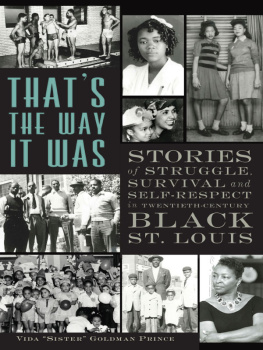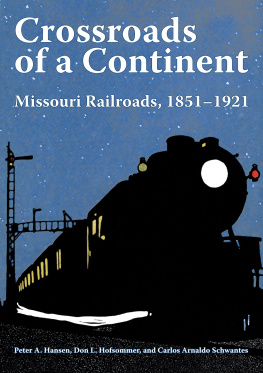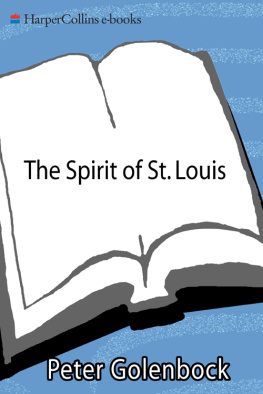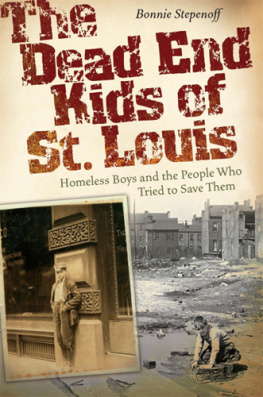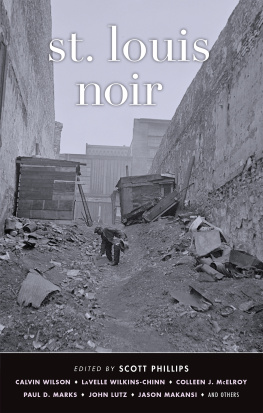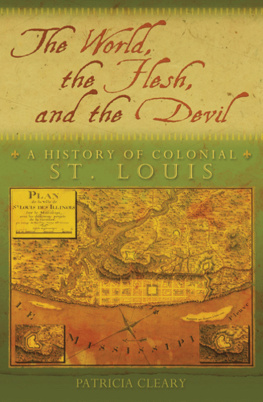Jo Allison (the pen name of Linda Dobkins) grew up in Missouri and spent ten years as a journalist, mostly for newspapers. She was the first woman to do television news in her hometown of Joplin, Missouri. Although she went on to teaching and researching, she believes reporting was the best education she could have had.
Allison writes historical fiction as well as nonfiction including a mystery series that begins in 1910 St. Louis.
I tender thanks and warmest regards to the staff of the Missouri Historical Society, who scrambled to provide articles and images amid a pandemic.
Chapter One
Charles van Ravenswaay, in Saint Louis: An Informal History of the City and its People, 17641865, 1991, for the traditional story of the citys founding and later feuds between Chouteau and Laclde descendants.
Katharine T. Corbett on Marie Thrse in Veuve Chouteau, a 250th Anniversary, in Gateway Heritage magazine, 1983. Corbett also as author and editor of In Her Place: A Guide to St. Louis Womens History, the essential source on everything female in St. Louis history to its publication in 1999.
Jay Gitlin in Constructing the House of Chouteau, in Commonplace (a journal of early American life), 2003.
William E. Foley in The Laclede/Chouteau Puzzle: John Francis McDermott Supplies Some Missing Pieces, in Gateway Heritage magazine, 1983.
Two standard histories: James Neal Primms Lion of the Valley: St. Louis, Missouri, 17641980, 1981; and Missouri: The WPA Guide to the Show-Me State, 1941.
For the revisionist history, Carl J. Ekberg and Sharon K. Person, The Making (and Perpetuating) of a Myth: Pierre Laclde and the Founding of St. Louis, in Missouri Historical Review, 2017.
Chapter Two
Kathryn Corbett on both Mitain and Mary Hempstead Lisa in In Her Place.
Richard Edward Oglesby for his biography, Manuel Lisa and the Opening of the Missouri Fur Trade, 1963.
The explorer quoted, Edwin James, Account of an Expedition from Pittsburgh to the Rocky Mountains, of the 1819 expedition.
Jay Gitlin again, Commonplace, 2003.
Interpretations of the Native American experience from Tanis Thorne in The Many Hands of My Relations: French and Indians on the Lower Mississippi, 1996.
Descriptions of Lisa and his exploits from van Ravenswaay (Informal History) and James Neal Primm (Lion of the Valley).
Chapters Three and Four
Adam Kloppe, for the Missouri Historical Society, The Louisiana Purchase and the Rise of Dueling in St. Louis, 2014.
Elbert Smith in Now Defend Yourself, You Damned Rascal, for American Heritage, available online, but originally from the magazine in 1958.
Primm again, in Lion of the Valley.
Andrew Wanko, Great River City: How the Mississippi Shaped St. Louis, 2019.
Bloody Island: Honor and Violence in Early Nineteenth-Century St. Louis, Charles van Ravenswaay, in his Informal History and as an article in Gateway Heritage, 1990.
J. Thomas Scharf in his monumental A History of St. Louis City and County, 1883.
Jim Winnerman, Death and Honor on Bloody Island, from Wild West Magazine, April 2020, reprinted on HistoryNet.
Crack of the Pistol: Dueling in 19th Century Missouri, from the Education site of the Missouri State Archives and Missouri Digital Heritage.
Dick Steward on Biddle and Pettis, and Kenneth H. Winn and Lawrence O. Christensen on Brown and Reynolds, respectively, in The Dictionary of Missouri Biography, 1999.
Beverly Bauser, The Abraham LincolnJames Shields Duel, September 22, 1842, on the Madison County, Illinois GenWeb site.
Chapter Five
Again, Primm in Lion of the Valley.
Ernest Kirschten, a Post-Dispatch editorial page writer, in Catfish and Crystal: A Story of St. Louis, U.S.A., 1989.
Charles C. Claytons Little Mack: Joseph B. McCullagh of the St. Louis Globe-Democrat.
Homer King, Pulitzers Prize Editor: A Biography of John A. Cockerill.
Versions of the shooting story all over the internet: The Slayback Homicide in a 2014 issue of the website Murder by Gaslight; for the Missouri Historical Society, Brittany Krewson, Tragedy in the Newsroom in 2018; Kerrigan Chapman, The Veiled Prophet: A History of Bigotry in St. Louis for Odyssey in 2017; Kirby Ross on James O. Broadhead: Ardent Unionist, Unrepentant Slaveholder for the website Civil War St. Louis in 2002.
For good, but very short, biographies of major St. Louis players buried in its elite graveyard, Carol Ferring Shepleys 2008 Tales from Bellefontaine Cemetery.
Mack McCullagh in the Globe-Democrat; and a staff-full of writers for the Post-Dispatch, October 1216, 1882.
Chapters Six and Seven
Writers weve met before: Scharf, Primm, Ravenswaay, Kirschten, Shepley, and Wanko.
Also: Katherine Douglass, writing in Katharine Corbetts In Her Place, on Harriet Scott.
Robert W. Tabscott, Elijah Parish Lovejoy: Portrait of a Radical: The St. Louis Years, 18271835, in Gateway Heritage, Winter 19871988.
John A. Bryan, The Blow Family and Their Slave Dred Scott, Bulletin of the Missouri Historical Society, 1948.
John Wright, Discovering African American St. Louis: A Guide to Historic Sites, second edition, 2002.
Robert Moore Jr., A Ray of Hope, Extinguished: St. Louis Slave Suits for Freedom, Gateway Heritage, Winter 19931994.
Bonnie E. Laughlin, Endangering the Peace of Society: Abolitionist Agitation and Mob Reaction in St. Louis and Alton, 18361838, Missouri Historical Review, October 2000.
For the matter of Hannahs death, General William S. Harney, Prince of Dragoons by George Rollie Adams, and a book edited by abolitionist Theodore D. Weld, American Slavery as It Is: Selections from the Testimony of a Thousand Witnesses, 1839.
Frederick A. Hodes, whose large volumes on St. Louis history describe everything from such major events as McIntoshs burning to how many people celebrated St. Patricks Day in a particular year, specifically, Rising on the River: St. Louis 1822 to 1850, published in 2009.
For details on the Scott lawsuit, Louis Gerteis, Civil War St. Louis.
Chapter Eight
James Neal Primm for details on riots.
Thomas Scharfs 1883 history, with eyewitness accounts of riots.
Ernest Kirschten and Frederick Hodes again.
On the Know-Nothings, an older source not specific to St. Louis: J. C. Furnas The Americans: A Social History of the United States, 15871914.
Father William B. Faherty, S.J., The St. Louis Irish: An Unmatched Celtic Community.
John C. Schneider in Riot and Reaction in St. Louis, 18541856, in Missouri Historical Review, January 1974.
And still here:
Soulard Farmers Market bills itself as the oldest west of the Mississippi, a phrase you hear a lot in St. Louis. Several buildings have occupied the site, but they seem to have been continuously busy for at least two centuries.


